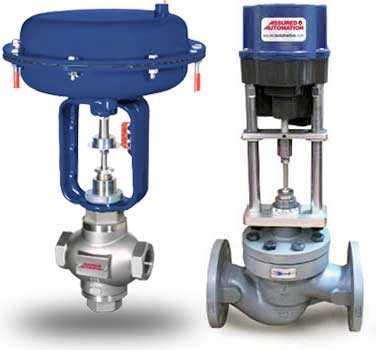Cutting-edge Control Valves: Enhancing Accuracy and Reliability
Cutting-edge Control Valves: Enhancing Accuracy and Reliability
Blog Article

Maximize Power Savings and Comfort With Advanced Structure Automation Controls
In the world of contemporary style and facility monitoring, the combination of sophisticated structure automation manages stands as a pivotal improvement. By harnessing the power of automation, buildings can adjust, react, and progress in methods that were once unbelievable.
Energy Efficiency Perks
Power efficiency benefits can substantially lower energy usage and functional costs in buildings. By implementing energy-efficient practices and innovations, building owners and operators can attain significant savings while likewise adding to environmental sustainability. One of the key advantages of enhancing energy effectiveness in structures is the decrease of utility expenses. Energy-efficient systems, such as innovative structure automation controls, can optimize the usage of resources like air conditioning, home heating, and lights, bring about reduced energy expenses gradually.
Additionally, improved energy efficiency can extend the lifespan of structure tools and systems. By running more successfully, HVAC systems, lighting fixtures, and other structure components experience less damage, leading to reduced maintenance and substitute expenses. Additionally, energy-efficient buildings typically regulate higher building values and rental prices, offering long-lasting financial advantages to owners.
Furthermore, energy efficiency can boost occupant convenience and performance. Properly controlled indoor settings with optimal lighting and thermal conditions produce an even more favorable and positive work area, leading to improved worker satisfaction and performance. Generally, the power effectiveness advantages associated with sophisticated building automation controls are complex, including expense financial savings, ecological stewardship, and owner well-being.
Improved Convenience Control
Enhancing comfort control in structure settings needs an innovative assimilation of innovative automation systems for optimum resident well-being. By using innovative building automation controls, centers can tailor the interior environment to satisfy the certain demands and preferences of owners. control valves.
Boosted comfort control exceeds basic temperature level modifications. It includes attributes such as individualized setups, occupancy sensing units, and all-natural light application to develop a receptive and vibrant atmosphere. By incorporating these sophisticated controls, structures can not only improve comfort yet also enhance power performance by optimizing system operations based upon actual occupancy and usage patterns. Ultimately, focusing on owner comfort with sophisticated automation systems leads to a much more delightful and much healthier interior environment.
Operational Efficiency Improvements

Additionally, the implementation of real-time surveillance and analytics devices allows building drivers to identify power inadequacies and operational abnormalities immediately. By continuously monitoring power usage patterns and system efficiency metrics, adjustments can be made in real-time to maximize energy consumption and make certain peak operational performance. control valves. Additionally, including demand feedback techniques right into building automation controls can additionally improve functional efficiency by dynamically changing power usage based upon grid conditions and prices signals
Indoor Environment Optimization
Efficient interior climate optimization is an essential facet of structure automation controls, making moved here sure occupants' convenience and health while making best use of energy cost savings. By making use of sophisticated sensors and controls, building automation systems can constantly check and adjust temperature level, moisture levels, air high quality, and air flow to develop an optimum interior environment. Keeping comfortable and consistent problems not just enhances occupant contentment but likewise enhances performance and total health.
Indoor climate optimization also plays an important function in energy efficiency. By fine-tuning air conditioning, air flow, and home heating systems based on real-time information and tenancy patterns, constructing automation controls can considerably lower power usage - control valves. Applying techniques such as demand-controlled ventilation and thermal zoning can assist minimize power waste while ensuring that each area of the building obtains the required conditioning.

Sustainable Setting Production
Building automation regulates not just enhance indoor environment problems for energy efficiency and passenger comfort yet likewise lay the foundation for developing a sustainable setting with calculated management of systems and resources. By incorporating advanced structure automation innovations, such as sensors, actuators, and smart software, facilities can readjust and monitor energy use in real-time to reduce waste and minimize their carbon footprint. These systems allow anticipating maintenance, determining possible issues prior to they rise and optimizing devices efficiency to enhance long life and efficiency.
Additionally, sustainable atmosphere production prolongs beyond power monitoring to encompass water conservation, waste decrease, and interior air top quality renovation. Structure automation controls can regulate water usage, find leakages, and ensure proper garbage disposal techniques, contributing to overall sustainability efforts. Furthermore, by regulating and monitoring ventilation and filtration systems, these innovations improve passenger Bonuses health and wellness and performance while lowering power usage connected with a/c procedures.
Conclusion
In final thought, advanced building automation controls deal substantial advantages in terms of energy savings, convenience control, functional efficiency, indoor environment optimization, and producing a sustainable atmosphere. By carrying out these controls, structures can accomplish ideal performance while reducing power consumption and improving occupant convenience. It appears that the use of sophisticated automation innovation is important in enhancing structure performance and creating a more lasting future.
Energy efficiency advantages can considerably decrease energy intake and operational prices in structures. Overall, the power effectiveness advantages associated with innovative building automation controls are multifaceted, encompassing expense savings, environmental stewardship, and occupant health.
In addition, incorporating demand reaction strategies into building automation controls can additionally boost functional performance by dynamically adjusting energy usage based on grid conditions and pricing signals.
Building automation controls not only enhance indoor climate conditions for energy efficiency and passenger convenience however likewise lay the foundation for producing a sustainable setting with calculated monitoring of systems and sources.In verdict, progressed structure automation manages offer significant benefits in terms of power financial savings, convenience control, functional effectiveness, indoor climate optimization, and producing a sustainable setting.
Report this page